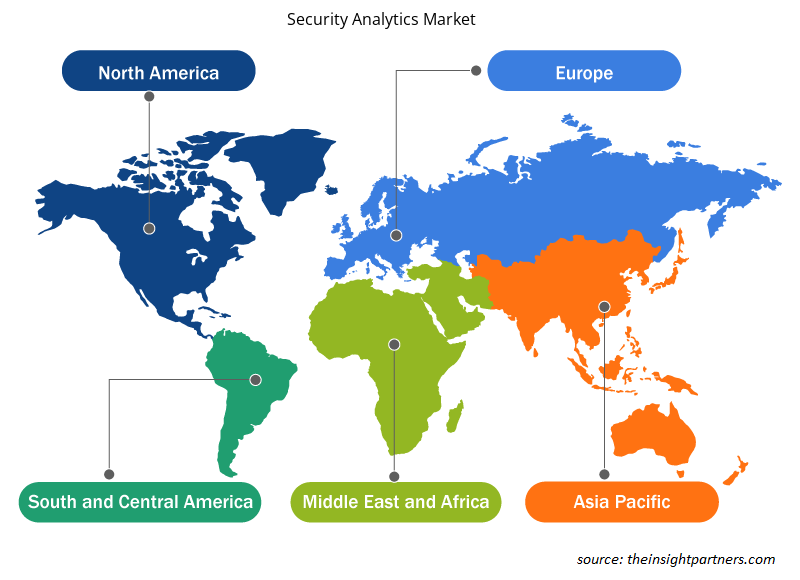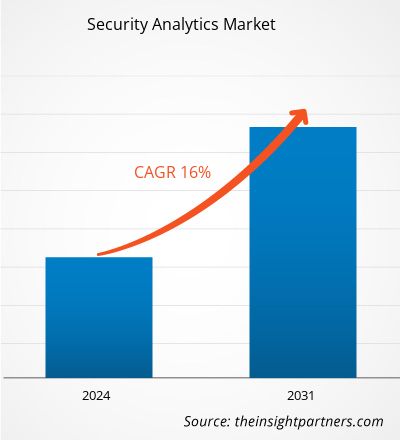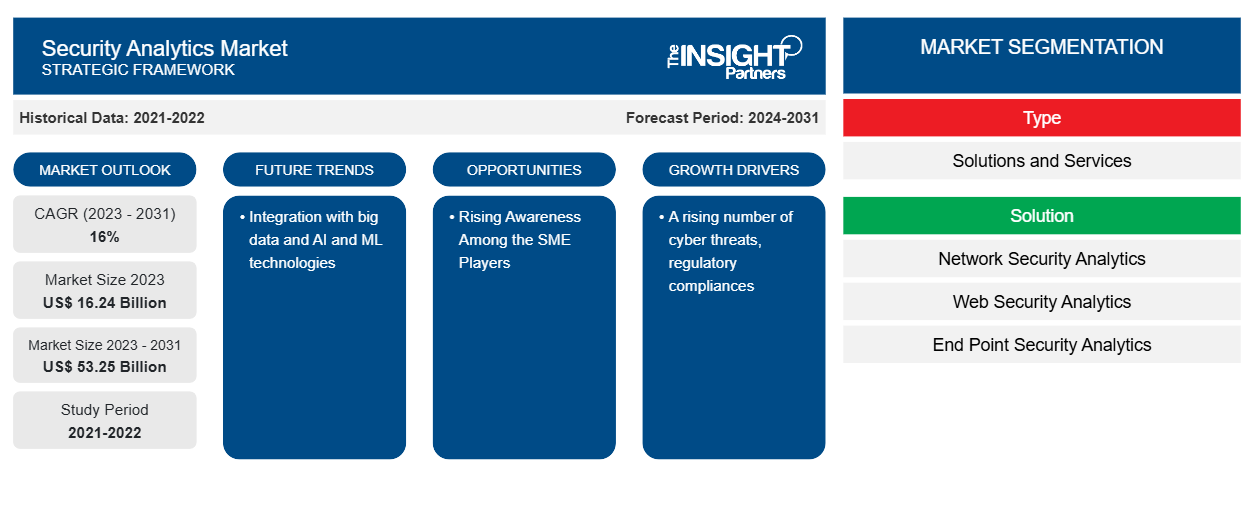من المتوقع أن يصل حجم سوق تحليلات الأمان إلى 53.25 مليار دولار أمريكي بحلول عام 2031 من 16.24 مليار دولار أمريكي في عام 2023.من المتوقع أن يسجل السوق معدل نمو سنوي مركب بنسبة 16.0% خلال الفترة 2023-2031. ومن المرجح أن يظل التكامل مع البيانات الضخمة وتقنيات الذكاء الاصطناعي والتعلم الآلي اتجاهًا رئيسيًا في السوق.
تحليل سوق تحليلات الأمان
تتزايد أهمية تحليلات الأمان بشكل متزايد للحفاظ على أمان المؤسسة مع استمرار تغير الشبكات وتزايد تعقيد التهديدات الأمنية. تساعد تحليلات الأمان فرق تكنولوجيا المعلومات والأمن في تحديد التهديدات بشكل استباقي (وتفاعلي) قبل أن تتسبب في فقدان البيانات أو عواقب سلبية أخرى من خلال دمج البرامج والخوارزميات والإجراءات التحليلية.
نظرة عامة على سوق تحليلات الأمان
إن التعلم الآلي والتحليل السلوكي والتخصيص هي القوى الرئيسية وراء التقدم في تكنولوجيا تحليلات الأمان اليوم. فبدلاً من مطالبة المستخدمين باستخدام بحيرات البيانات الخاصة، تسمح العديد من حزم SIEM الآن للمؤسسات باستخدام بحيراتها الحالية. بالإضافة إلى ذلك، جعلت العديد من الحلول نماذج التعلم الآلي والإثراء والتحليلات الخاصة بها متاحة للجمهور حتى يتمكن العملاء من فهمها وتعديلها بشكل أفضل حسب الضرورة. ومن أجل معالجة اكتشاف التهديدات والاستجابة لها بطريقة أكثر أتمتة وثراءً بالقياس عن بعد، بدأت الصناعة في دمج SIEM وتحليلات سلوك كيان المستخدم (UEBA) وتنسيق الأمان والأتمتة والاستجابة (SOAR) والكشف والاستجابة الموسع (XDR). وقد تقدمت تحليلات الأمان بسرعة في السنوات الأخيرة.
قم بتخصيص هذا التقرير ليناسب متطلباتك
ستحصل على تخصيص لأي تقرير - مجانًا - بما في ذلك أجزاء من هذا التقرير، أو تحليل على مستوى الدولة، وحزمة بيانات Excel، بالإضافة إلى الاستفادة من العروض والخصومات الرائعة للشركات الناشئة والجامعات
-
احصل على أهم اتجاهات السوق الرئيسية لهذا التقرير.ستتضمن هذه العينة المجانية تحليلاً للبيانات، بدءًا من اتجاهات السوق وحتى التقديرات والتوقعات.
محركات وفرص سوق تحليلات الأمان
تزايد التهديدات السيبرانية لصالح السوق
بفضل قدرتها على الاستفادة من أحدث التقنيات للكشف عن التهديدات المحتملة، والكشف عن الثغرات الخفية، وتزويد المؤسسات بالرؤى التي تمكنها من تعزيز دفاعاتها والتخفيف من المخاطر بشكل استباقي، أصبحت تحليلات الأمان أداة لا غنى عنها في المعركة المستمرة ضد مجرمي الإنترنت. وفقًا لتقرير صادر عن شركة Check Point Software Technologies Ltd. في عام 2024، كان هناك زيادة مطردة في التهديدات الإلكترونية في عام 2023. في كل أسبوع، كان هناك ما معدله 1158 هجومًا إلكترونيًا ضد الشركات في جميع أنحاء العالم. يشير هذا إلى اتجاه ثابت ومثير للقلق في مشهد التهديدات الرقمية، مع ارتفاع الهجمات الإلكترونية بنسبة 1٪ عن عام 2022 والحفاظ على النمو الملحوظ عن السنوات السابقة. هذا هو ما يدفع سوق تحليلات الأمان.
زيادة الوعي بين اللاعبين في الشركات الصغيرة والمتوسطة
تشير دراسة أجرتها مؤسسة CyberPeace Foundation إلى أن 43% من جميع الهجمات الإلكترونية تستهدف الشركات الناشئة والصغيرة. كما تفتقر حوالي 46% من الشركات الصغيرة والمتوسطة الحجم إلى المعرفة بإدارة المخاطر في المجال الرقمي. تُعَد التهديدات الإلكترونية تهديدًا حقيقيًا، وأصبحت أساليب عملها أكثر تعقيدًا. وفي حين أن غالبية المنظمات الكبيرة الراسخة لديها تدابير أمنية مناسبة لدرء المخاطر مثل البرامج الضارة وانتهاكات البيانات، فإن الشركات الصغيرة أكثر عرضة لمخاطر الأمن الإلكتروني بسبب مواردها المحدودة. وبالتالي، فإن هذا يفتح فرصًا لتبني أدوات تحليلات الأمان بين الشركات الصغيرة والمتوسطة الحجم.
تقرير تحليلات سوق الأمن وتحليل التجزئة
كانت القطاعات الرئيسية التي ساهمت في اشتقاق تحليل سوق تحليلات الأمان هي النوع والحل والنشر والقطاع الرأسي.
- بناءً على النوع، ينقسم سوق تحليلات الأمان إلى حلول وخدمات. وقد استحوذ قطاع الحلول على الحصة الأكبر في عام 2023.
- بناءً على الحل، يتم تقسيم السوق إلى تحليلات أمان الشبكة، وتحليلات أمان الويب، وتحليلات أمان نقطة النهاية، وغيرها.
- بناءً على النشر، يتم تقسيم السوق إلى محلي وسحابي وهجين.
- استنادًا إلى القطاع الصناعي، يتم تقسيم السوق إلى BFSI، والاتصالات وتكنولوجيا المعلومات، والحكومة والدفاع، والسلع الاستهلاكية والتجزئة، وغيرها.
تحليل حصة سوق تحليلات الأمان حسب المنطقة الجغرافية
ينقسم النطاق الجغرافي لتقرير سوق تحليلات الأمان بشكل أساسي إلى خمس مناطق: أمريكا الشمالية، ومنطقة آسيا والمحيط الهادئ، وأوروبا، والشرق الأوسط وأفريقيا، وأمريكا الجنوبية والوسطى.
ستستحوذ أمريكا الشمالية على حصة كبيرة من سوق تحليلات الأمن في عام 2023. تعد أمريكا الشمالية واحدة من أكثر المناطق تأثرًا بالهجمات الإلكترونية في العالم. ويرجع ذلك إلى الوجود البارز للقطاعات المالية والبنية الأساسية الأساسية والفرص المشتركة، مثل الشراكات بين القطاعين العام والخاص، والتي تساهم جميعها في إنشاء نظام بيئي إلكتروني أكثر قوة. تركز الحكومات الإقليمية على تعزيز التشريعات والسياسات لمكافحة المخاطر الإلكترونية في بلدانها. وهذا يدفع الطلب على سوق تحليلات الأمن في المنطقة.
رؤى إقليمية حول سوق تحليلات الأمان
لقد قام المحللون في Insight Partners بشرح الاتجاهات والعوامل الإقليمية المؤثرة على سوق تحليلات الأمان طوال فترة التوقعات بشكل شامل. يناقش هذا القسم أيضًا قطاعات سوق تحليلات الأمان والجغرافيا في جميع أنحاء أمريكا الشمالية وأوروبا ومنطقة آسيا والمحيط الهادئ والشرق الأوسط وأفريقيا وأمريكا الجنوبية والوسطى.

- احصل على بيانات إقليمية محددة لسوق تحليلات الأمان
نطاق تقرير سوق تحليلات الأمان
| سمة التقرير | تفاصيل |
|---|---|
| حجم السوق في عام 2023 | 16.24 مليار دولار أمريكي |
| حجم السوق بحلول عام 2031 | 53.25 مليار دولار أمريكي |
| معدل النمو السنوي المركب العالمي (2023 - 2031) | 16% |
| البيانات التاريخية | 2021-2022 |
| فترة التنبؤ | 2024-2031 |
| القطاعات المغطاة |
حسب النوع
|
| المناطق والدول المغطاة |
أمريكا الشمالية
|
| قادة السوق وملفات تعريف الشركات الرئيسية |
|
كثافة اللاعبين في سوق تحليلات الأمان: فهم تأثيرها على ديناميكيات الأعمال
يشهد سوق تحليلات الأمان نموًا سريعًا، مدفوعًا بالطلب المتزايد من المستخدم النهائي بسبب عوامل مثل تفضيلات المستهلكين المتطورة والتقدم التكنولوجي والوعي المتزايد بفوائد المنتج. ومع ارتفاع الطلب، تعمل الشركات على توسيع عروضها والابتكار لتلبية احتياجات المستهلكين والاستفادة من الاتجاهات الناشئة، مما يؤدي إلى زيادة نمو السوق.
تشير كثافة اللاعبين في السوق إلى توزيع الشركات أو المؤسسات العاملة في سوق أو صناعة معينة. وهي تشير إلى عدد المنافسين (اللاعبين في السوق) الموجودين في مساحة سوق معينة نسبة إلى حجمها أو قيمتها السوقية الإجمالية.
الشركات الرئيسية العاملة في سوق تحليلات الأمان هي:
- شركة آي بي إم
- شركة هيوليت باكارد لتطوير المشاريع (HPE)
- شركة سيسكو سيستمز
- شركة برودكوم
- ماكافي، ذ.م.م
- شركة سبلانك
إخلاء المسؤولية : الشركات المذكورة أعلاه ليست مرتبة بأي ترتيب معين.

- احصل على نظرة عامة على أهم اللاعبين الرئيسيين في سوق تحليلات الأمان
أخبار سوق تحليلات الأمان والتطورات الأخيرة
يتم تقييم سوق تحليلات الأمان من خلال جمع البيانات النوعية والكمية بعد البحث الأولي والثانوي، والتي تتضمن منشورات الشركات المهمة وبيانات الجمعيات وقواعد البيانات. فيما يلي بعض التطورات في سوق تحليلات الأمان:
- أعلنت شركة IBM (NYSE: IBM) اليوم عن تطور كبير في منتجها الرائد IBM QRadar SIEM: إعادة تصميمه على بنية سحابية جديدة، تم تصميمها خصيصًا لحجم السحابة الهجينة والسرعة والمرونة. كما كشفت IBM عن خطط لتقديم قدرات الذكاء الاصطناعي التوليدي ضمن مجموعة اكتشاف التهديدات والاستجابة لها - بالاستفادة من Watsonx، منصة البيانات والذكاء الاصطناعي الجاهزة للمؤسسات من الشركة. (المصدر: IBM، بيان صحفي، نوفمبر 2023)
- تتعاون شركة Symantec، وهي قسم من شركة Broadcom Inc. (NASDAQ: AVGO)، مع Google Cloud لدمج الذكاء الاصطناعي التوليدي (gen AI) في منصة Symantec Security في طرح تدريجي من شأنه أن يمنح العملاء ميزة تقنية كبيرة للكشف عن الهجمات الإلكترونية المعقدة وفهمها ومعالجتها. (المصدر: Broadcom Inc.، بيان صحفي، سبتمبر 2023)
تقرير سوق تحليلات الأمان والتغطية والنتائج المتوقعة
يوفر تقرير "حجم سوق تحليلات الأمان والتوقعات (2021-2031)" تحليلاً مفصلاً للسوق يغطي المجالات التالية:
- حجم سوق تحليلات الأمان وتوقعاته على المستويات العالمية والإقليمية والوطنية لجميع قطاعات السوق الرئيسية التي يغطيها النطاق
- اتجاهات سوق تحليلات الأمان، بالإضافة إلى ديناميكيات السوق مثل المحركات والقيود والفرص الرئيسية
- تحليل مفصل لقوى PEST/Porter الخمس وSWOT
- تحليل سوق تحليلات الأمان الذي يغطي اتجاهات السوق الرئيسية والإطار العالمي والإقليمي واللاعبين الرئيسيين واللوائح والتطورات الأخيرة في السوق
- تحليل المشهد الصناعي والمنافسة الذي يغطي تركيز السوق، وتحليل خريطة الحرارة، واللاعبين البارزين، والتطورات الأخيرة لسوق تحليلات الأمان
- ملفات تعريف الشركة التفصيلية
- التحليل التاريخي (سنتان)، سنة الأساس، التوقعات (7 سنوات) مع معدل النمو السنوي المركب
- تحليل PEST و SWOT
- حجم السوق والقيمة / الحجم - عالمي، إقليمي، بلد
- الصناعة والمنافسة
- مجموعة بيانات إكسل
التقارير الحديثة
تقارير ذات صلة
شهادات العملاء
سبب الشراء
- اتخاذ قرارات مدروسة
- فهم ديناميكيات السوق
- تحليل المنافسة
- رؤى العملاء
- توقعات السوق
- تخفيف المخاطر
- التخطيط الاستراتيجي
- مبررات الاستثمار
- تحديد الأسواق الناشئة
- تحسين استراتيجيات التسويق
- تعزيز الكفاءة التشغيلية
- مواكبة التوجهات التنظيمية























 احصل على عينة مجانية ل - سوق تحليلات الأمان
احصل على عينة مجانية ل - سوق تحليلات الأمان